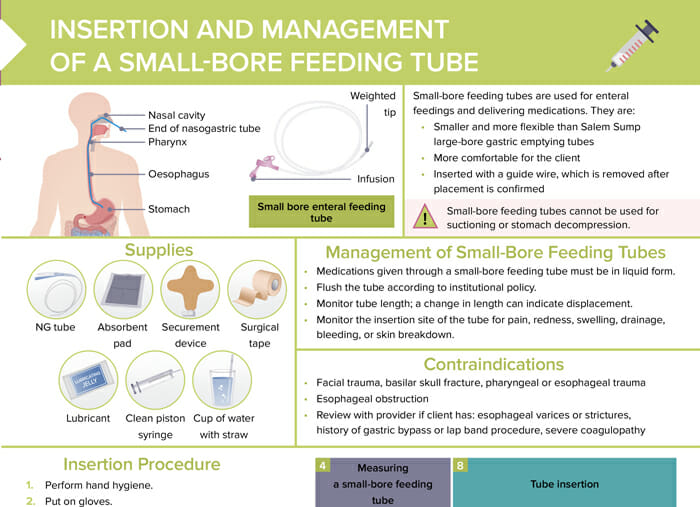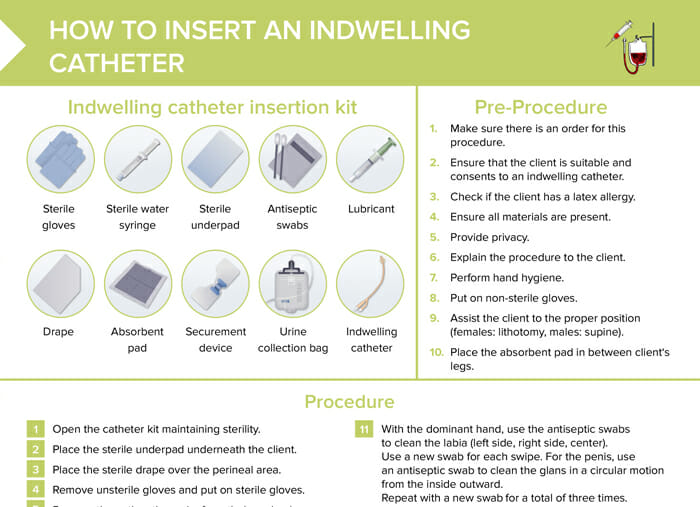What are the different types of indwelling urinary catheters?
- Indwelling urinary (Foley) catheters: inserted into the bladder through the urethra, small, inflated balloon to keep in place (urine drains into bag)
- Intermittent catheters: used short-term to empty bladder (for medical procedures or when urinary retention)
- Suprapubic catheters: inserted through a small hole in the abdomen into the bladder (often used when the urethra is blocked or damaged, or long-term)
- Condom catheters: used for men who suffer from incontinence, condom-like sheath with tube
What supplies are needed for Foley catheter insertion?
Indwelling catheter insertion kit:
- Sterile gloves
- Sterile water syringe
- Sterile underpad
- Antiseptic swabs
- Lubricant
- Drape
- Absorbent pad
- Securement device
- Urine collection bag
- Indwelling catheter
Steps for preparing for an indwelling urinary catheter insertion
- Ensure procedure is ordered
- Ensure client is suitable and consents
- Check client for latex allergy
- Ensure you have all needed supplies
- Provide privacy and explain procedure to client
- Perform hand hygiene and put on non-sterile (clean) gloves
- Assist client to proper position (lithotomy/supine)
- Place absorbent pad between client’s legs
How to insert a Foley catheter (step-by-step)
- Open the catheter kit maintaining sterility.
- Place the sterile underpad underneath the client.
- Place the sterile drape over the perineal area.
- Remove unsterile gloves and put on sterile gloves.
- Remove the antiseptic swabs from their packaging.
- Attach the sterile water syringe to the balloon inflation
- port.
- Open the lubricant packet and squeeze lube onto the packing tray.
- Remove the catheter cover.
- With the sterile dominant hand, dip the catheter tip into the lubricant.
- Using the nondominant hand, separate the labia minora or hold the penis at a 60–90-degree angle and retract the foreskin (if applicable).
- With the dominant hand, use the antiseptic swabs to clean the labia (left side, right side, center). Use a new swab for each swipe.
- For the penis, use an antiseptic swab to clean the glans in a circular motion from the inside outward. Use a new swab for each swipe, for a total of three times.
- With the dominant hand, slowly insert the catheter into the urethra. Instruct the client to breathe normally and that some pressure is expected. Do not force a catheter if resistance is felt.
- Continue to hold the labia apart or hold the penis in place as the dominant hand advances the catheter inward. Slowly advance until urine is seen in the catheter tubing.
- Engage the sterile water syringe to inflate the balloon.
- Release your non-dominant hand and adjust the catheter as needed.
- Secure the catheter to the client’s thigh using the securement device.
- Secure the urine collection bag lower than the client’s position.
Related videos
How to care for a client with an indwelling urinary catheter
- Ensure that urine collection bag is lower than client’s bladder
- Change urine collection bag regularly as needed or per protocol of facility
- Monitor urine output, color and signs of infection or other complications
What are potential complications of indwelling urinary catheters?
Potential complications of indwelling catheters include:
- Urinary tract infections (UTIs)
- Bladder spasms or discomfort
- Blockages in the urinary tract due to sediment buildup or blood clots
- Accidental removal of the catheter

